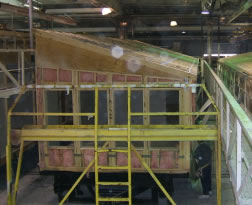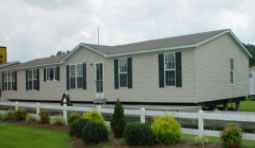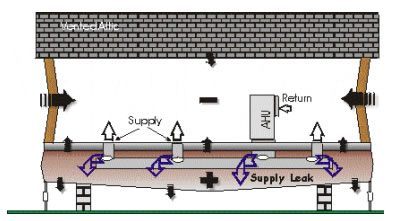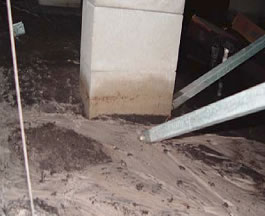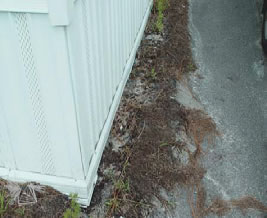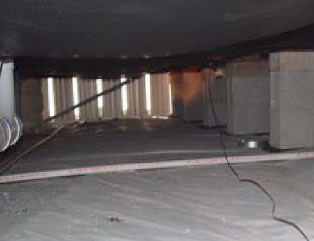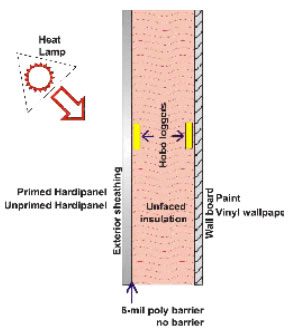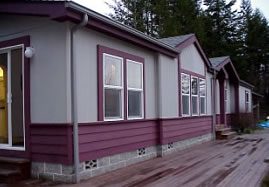|
BAIHP
Research: A. Manufactured Housing Research Cont'd
- Building Science and Moisture Problems
in Manufactured Housing
Papers: Subrato Chandra, Danny Parker, David Beal, David
Chasar, Eric Martin, Janet McIlvaine, Neil Moyer. Alleviating
Moisture Problems in Hot, Humid Climate Housing. Position
Paper for NSF Housing Research Agenda Workshop, UCF Feb.
12-14, 2004.
Moyer,
N., Beal, D., Chasar, D., McIlvaine, J., Withers, C, & Chandra, S. (2001). “Moisture Problems in
Manufactured Housing: Probable Causes and Cures.” ASHRAE
- IAQ 2001 Conference Proceedings, San Francisco, CA.
|
Figure 45 Palm
Harbor HUD Code Manufactured Housing factory – production
line. |
|
Figure
46 Completed
HUD Code Manufactured Home, Palm Harbor Homes. |
Manufactured
homes have a permanent steel chassis attached below the floor
and are constructed in a factory (Figure 45) to
meet a national code maintained by the U.S. Department of
Housing and Urban Development (HUD). After production, homes
may travel a few hundred miles, hauled by truck, before final
setup. The homes are setup by placing blocks under the steel
I-beams and anchoring the beams firmly to the ground. A skirting
covers the blocks and steel frame in a fully setup home (Figure
46).
Manufactured
homes are typically heated or cooled by a system of ductwork,
which delivers hot or cold air from the air handler unit
(AHU). The ductwork can be in the attic or in the belly cavity
of the home. The ducts are typically made of aluminum or
fiberglass trunk lines which supply air to the floor registers
through in-line boots or flex ducts. The boots or ducts terminate
at perimeter registers on the floor. Supply duct leaks represent
one of the biggest causes of moisture problems in manufactured
homes. (Figures 47 and 48). Poor design and construction
leave holes at the AHU connection to the main trunk, and
where the boots connect to the trunk, supply registers, end
caps, cross-over duct connections, and other connection points.
When the AHU blows air, some air leaks into the belly and
eventually to the outside through belly board tears. This
loss of air creates a negative pressure inside the house
and a positive pressure in the belly. The negative pressure
pulls outside or attic air into the house through cracks
and crevices which connect the inside of the house to the
outside or to the attic. During northern winters, this outside
air is cold and dry and its entry increases occupant discomfort
and heating energy use.
|
| Figure
47 Pressure field and unintentional
air flow created by supply duct leaks. |
During
summer in the Southeastern US, the air is consistently at
or above the dewpoint of 75. If a homeowner keeps their home
thermostat set below this 75 F dewpoint, the moisture laden
outside air condenses as it comes into contact with the cold
inside surfaces. If it condenses behind an impermeable surface
such as vinyl flooring or wallpaper, serious mold, mildew,
and floor buckling problems can result.
Many manufactured and site-built homes have only a single
return and, therefore, very little return air transfer from
the bedrooms (basically via the undercut at the bottom of
interior doors). When interior doors are closed, rooms off
the main body (e.g., bedrooms) become pressurized and the
main body of the house depressurizes. Even though negative
pressures are usually only one to three pascals (Pa) - they
can cause serious problems in a home.
Researchers
use a calibrated fan called a ductblaster to measure duct
leakage. The ductblaster is attached to the return grill
or the crossover duct opening (Figure 49) and
all supply registers are masked off and the fan is turned
on. Once the house ductwork reaches –25 Pa, airflow
through the fan is read (in CFM). The resultant measure
is the total duct leakage. In good airtight ductwork, total
duct leakage (CFM@25 Pa) should be less than 6% of the
homes square footage.
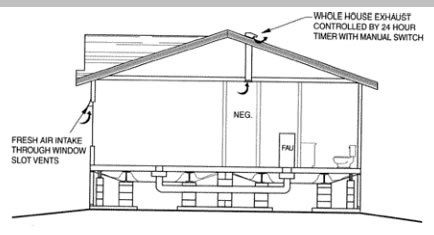 |
| Figure 48 Cross section
showing foundation support, crossover duct, and one
type of ventilation system in a manufactured home. |
A
second duct leakage test measures leakage to the outside.
This leakage is calculated by depressurizing the entire
house to –25 Pa with a blower
door, then adjusting the ductblaster flow so there is no pressure difference
between the house and the ducts. This measurement is a true indicator of
duct air loss to the outside and is used in energy calculations for estimating
the energy loss from leaky ducts. In good duct systems, duct leakage to
the outside (in CFM) is less than 3% of the home’s
square footage.
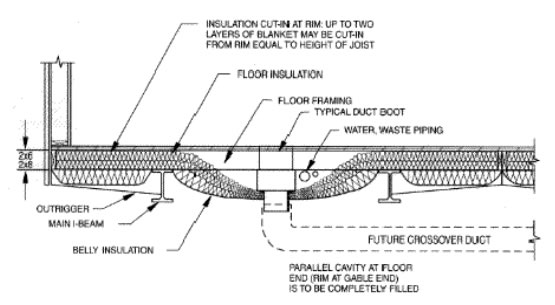 |
| Figure 49 Floor and
belly area with supply ducts. These ducts supply conditioned
air to all rooms through floor vents, a common duct
system layout in manufactured homes. |
The battery of tests run
in a problem house typically includes measuring
the airtightness of the house with a blower door,
depressurizing the house to –50 Pa. At
that time, the house to belly and belly to crawlspace
pressures also can be measured. Researchers also
test pressure differentials caused by AHU operation
and closed interior doors. An additional measurement
of duct leakage, called pressure pan, is conducted
on some houses to pinpoint specific registers which might
have large leaks. In this measurement the house is first
depressurized to –50 Pa and all the register vents
are unmasked. Then the registers are covered one by one
and the pressure difference between the covered register
and the house is measured. A zero reading indicates no
leakage at that register. Readings over one Pa indicate
a sizeable leak that should be repaired.
- BAIHP
Field Visits to Moisture Problem Homes
Papers:
Moyer, N., Beal, D., Chasar, D., McIlvaine, J., Withers,
C, & Chandra, S. (2001). “Moisture
Problems in Manufactured Housing: Probable Causes and
Cures.” ASHRAE - IAQ 2001 Conference Proceedings,
San Francisco, CA.
A significant number of new manufactured houses built
to HUD code and located in the hot, humid Southeast have
exhibited moisture problems. Soft wallboards, buckled
floors, damaged wood molding, and extensive mold growth
are the most common symptoms. These problems do not respond
to the standard service and repair strategies for water
intrusion. (Please see Appendix B for sample problem
home inspection trip reports.)
Summary of 1 st-4 th Budget Period Field Visits to
Moisture Problem Homes
At
the request of six manufacturers, 69 such moisture damaged
homes were investigated from 1999 to the end of reporting
year four (through March 31, 2003) to determine likely
causes. In Year 4 alone, 18 homes were investigated by
FSEC. One-time blower door, duct tightness, and pressure
differential measurements were performed on all homes.
Field data on ambient, crawlspace, belly and house temperatures,
plus relative humidity levels were collected on a few of
the homes. Recommendations and reports were prepared for
the manufacturers’ service, production, and
design staff. Field repairs were performed in most
of these homes. A general theme was found in the houses
investigated.
- Air conditioner thermostat settings (typically 68
to73 F) set below the ambient dew point.
- Negative
pressures across the envelope from high supply duct leakage
(CFM @25Pa >10
per 100 square feet of conditioned floor
area), inadequate return air paths, interior
door closures, exhaust fans, or a combination
thereof.
- Inadequate moisture removal from disconnected return
ducts, continuous fan operation (air handler
or ventilation), inadequate condensate drainage, oversized
air conditioners, or a combination thereof.
- Moisture diffusion from the ground into the house
because of poor site drainage, inadequate
crawl space ventilation, tears in the belly board, or a
combination thereof.
- Vapor-retardant in the wrong location (i.e., vinyl
or other impermeable wall or floor coverings
located on the colder surfaces).
Recommended solutions provided to the manufacturers
to eliminate moisture problems included:
- Maintain air conditioning thermostat settings above
the ambient dew point (at least 75 F).
- Eliminate long-term negative pressures created by
air handler fans or ventilation equipment.
- Tightly seal all ductwork and provide adequate return
air pathways.
- Enhance moisture removal from the conditioned space
by correct equipment sizing and maintenance.
- Eliminate ground source water and provide an adequate
moisture barrier for the floor assembly.
- If possible, remove vapor barriers located on the
wrong surfaces.
Research continues to determine if these steps will
be sufficient to prevent problems even when vapor barriers
are incorrectly located in homes in the hot, humid climate.
Preliminary results are encouraging. One manufacturer
has not reported a single new moisture problem in any
of the homes produced since 2000 in a factory that previously
had a significant number of problem homes. Steps taken
by the factory were inclusion of airtight duct systems
(a zero net-cost increase), right-sized cooling systems
(a negative cost), return air ducts from all bedrooms
(a cost of about $15), installation of a ground vapor
barrier (no change from previous practice).
Summary of 5 th Budget Period Field Visits to Moisture
Problem Homes
|
Figure
52 HUD Code
required perforations in skirting may not allow adequate
volumes of ventilation, creating higher than usual
vapor pressure difference across the floor assembly
even though the ground cover and belly board are in
good condition. |
BAIHP researchers at FSEC received fewer requests in the
5 th budget period for assistance with moisture damaged homes (Table
27), reflecting improvement of duct construction and
sealing, addition of return air pathways from bedrooms, and
reduction of vapor impermeable interior surfaces. Additionally,
service personnel who have attended BAIHP training and participated
in field work with BAIHP are more prepared to resolve problems
without assistance. Service personnel report installing passive
return air vents in bedrooms, providing appropriate moisture
barriers, and sealing duct leaks to resolve humidity, comfort,
and moisture damage call backs.
When service personnel have been unable to resolve a problem,
they request assistance from BAIHP researchers who attend
a service call and conduct various diagnostic tests to identify
factors contributing to the moisture, comfort, or high energy
bill problem. (MHRA has been providing similar services on
a fee basis to the industry also.) After BAIHP researchers
complete a field visit, a trip report is issued detailing
the findings and recommendations, include basic building
science background material.
Table
27 5th Budget Period – FSEC Field Visits
to Problem Manufactured Homes
|
Manufacturer |
Location |
Date |
Fleetwood Homes |
Florida (2 homes) |
August 03 |
| . |
Florida (2) |
November 03 |
| . |
Texas (1) |
December 03 |
| . |
West Virginia (1) |
March04 |
Cavalier Homes |
Florida (1) |
November 03 |
Southern Energy Homes |
Kentucky(1) |
December 03 |
| . |
Texas (1) |
January 04 |
Style Crest |
Louisiana (1) |
February 03 |
20 NEEM Program Manufacturers |
Field Visits in Washington, Oregon,
and Idaho (19) |
April 03-March 04 |
Total Homes |
29 |
. |
It
has been BAIHP’s experience that corrective measures
from repeated moisture problem Diagnostics have been incorporated
into the production process, resulting in thousands of improved
manufactured homes. These are noted in Category D of
Table 2.
A common problem that remains unresolved involves the combination
of abundant crawl space moisture (Figure 50 and 51) and
poorly vented skirting (Figure 53). In the hot-humid
coastal regions, this combination raises vapor pressure across
the belly to critical levels. This was evident in several
of the homes visited this year. As a result of this field
research, BAIHP has designed a study that will be initiated
in the summer of 2004 to evaluate the moisture flow characteristics
of crawl space conditions.
Northwest BAIHP Random Home Testing
SGC Random Home Testing: In 1994-1995 (prior
to implementation of BAIHP), SGC staff conducted field testing
of 178 SGC homes built in 1992-1993. In 1999, the first year
of the BAIHP effort, staff in Idaho and Washington field-tested
49 SGC homes built in 1997-98. In 2000, analysis of field
test data confirmed some improvements to home set-up procedures
and air leakage control, while highlighting a need to improve
duct tightness and ventilation system operation (through
homeowner education.) In 2001, BAIHP staff produced an updated
homeowner ventilation brochure.
In 2002 and 2003, BAIHP staff worked with Ecotope to develop
a valid sample for the next round of field testing, and began
to develop the field testing protocol. In 2004, Ecotope selected
105 homes from the total production for the years 2001-2002.
The field testing took place in the summer of 2004. Findings
from the testing include:
- Average house size is 1769 ft 2; double section homes
are also getting bigger, on average. The house size is
very comparable to the homes built in 1997-1998 but 20%
larger than the homes in 1994-1995 study
- Houses are getting tighter, according to the blower
door results. The average air leakage rate at 50 Pa is
4.2, which represents a tightening of almost 25% over the
original MAP home average. The median equivalent leakage
area (ELA) for double-section homes has decreased by about
12% despite a substantial increase in house size.
- Only about 20% of NEEM homes in this study contain intentional
outside air inlets. This is the result of BAIHP research
indicating that intentional outside air inlets are unnecessary
to provide adequate fresh air.
- 2/3 of homes in the study have dedicated whole house
fans and a substantial fraction of homeowners are using
their whole house fans. However, a significant minority
(30%) does not turn them on.
- About half of homes in the study use central cooling,
with more than half of these homes using a heat pump.
- Duct systems are about 20% leakier than in the Year
1 study and about 10% leakier than in the 1994-1995 study
(when the comparison is normalized by house size).
- The median supply leakage fraction is 11-13% for the
homes in this sample. The duct loss translates into a heating
system efficiency loss of between 10-20% overall, depending
on the location of the home (west side or east side of
the mountains) and type of heating equipment (heat pumps
perform worse).
In 2004, BAIHP staff conducted a billing analysis on a
limited number of random field study homes. The conclusions
(although not statistically significant) suggest that temperature
related energy use in NEEM homes remains similar to previous
larger studies on cost-effectiveness. The analysis attempted
to evaluate total and space conditioning energy use by HVAC
system types but was limited by small sample size.
In
2004, a sub-sample of homes that are believed to represent
the best case for duct tightness were selected for additional
field testing. These homes include those with in-plant tested
ducts and thru-rim crossover duct systems. The goal of this
effort is to establish a “tightest” duct case
benchmark. Field testing will be completed in 2005; report
will follow.
Northwest BAIHP Field Visits to Problem Manufactured
Homes
|
Figure
51 The downstream
exit for the water draining across the site via the
crawl space. Note flow pattern away from house. |
|
Figure
52 HUD Code
required perforations in skirting may not allow adequate
volumes of ventilation, creating higher than usual
vapor pressure difference across the floor assembly
even though the ground cover and belly board are in
good condition. |
In
offering technical support to owners of over 100,000 homes
built since 1990, the BAIHP staff in the Northwest answers
questions from homeowners, manufacturers, retailers and
others. In The 6th budget period, staff from Washington,
Oregon and Idaho responded to over 70 phone calls and conducted
27 field visits. The number of field visits to problem
homes has significantly decreased over the history of the
program, in large part because of manufacturers’ and installers’ increased
adoption of the NEEM Super Good Cents/Energy Star (SGC/E-Star)
specifications which include duct air tightness specifications
(duct leakage is a major contributor to pressure and air
flow related moisture problems), and the requirement that
manufactured home installers be certified in Washington and
Oregon.
Northwest BAIHP staff began to utilize Energy Gauge USA
as a toll for evaluating high bill complaints in 2003-2004.
BAIHP staff participated in quarterly meetings of the Washington
State Manufactured Housing Technical Working Group, which
coordinates the certification of manufactured housing set-up
crews.
While butyl duct tape is no longer allowed under current
NEEM SGC/E-Star specifications, a consistent issue in the
field continues to be excessive duct leakage, due in large
part to failures of duct tape. These findings were brought
to the attention of the NFPA-501 Manufactured Housing Standards
Committee, resulting in a successful proposal to revise the
duct sealing specifications to eliminate the use of duct
tape in favor of better performing mastic and fiberglass
mesh in the NFPA-501 standard. See a summary of supporting
research findings in BAIHP Duct Data Compilation.
Blue Sky Foundation
Blue Sky Foundation, in coordination with FSEC, conducted
an evaluation of energy efficiency and the moisture damage
potential in 16 North Carolina homes in the summer of 2001.
Blue Sky foundation proposed that the energy and moisture
evaluation focus on the building envelope integrity, HVAC
duct systems, and the moisture impact of unvented space heaters.
All of the homes in the study were manufactured models located
in Carteret and Craven counties, each located on the North
Carolina coast. Field teams gathered additional energy and
moisture information from homeowners.
Only three of the 15 tested homes recorded moisture and/or
mildew problems. Because of the small sample size, the results
are mostly anecdotal and would need to be evaluated within
a larger data set. Planning for this is underway. Data from
the summer field program as well as the final report are
now on the BAIHP website (www.baihp.org)
under Publications.
Cavalier Homes
BAIHP visited one Cavalier Home in Florida for a moisture
damage investigation in response to home owner complaints
of persistent air flow problems and floor damage. BAIHP made
recommendations to correct the installation of the duct system
and supply registers, repair the rodent barrier to make it
air tight, do site work to reduce flooding under house, place
a ground cover if site work done, increase crawl space venting,
and replace damaged flooring with plywood.
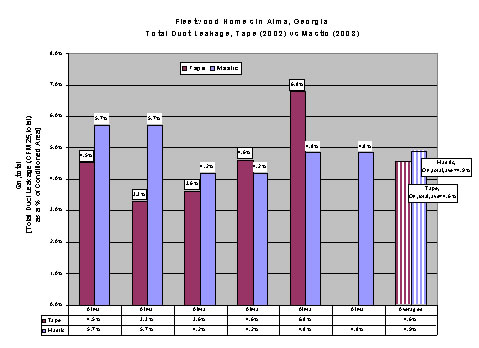
Figure 53 Testing Results
from Fleetwood Homes Plant in Alma, Georgia
illustrate
that tape sealed ducts can result in total duct leakage
under
Qn=<6%.
This initial tightness, however, is often eroded by adhesive
failure.
Fleetwood Homes
During
the 5 th budget period, BAIHP continued to support Fleetwood’s
service department making six visits to moisture damaged
homes in Florida (4), Texas (1), and West Virginia (1).
Six Fleetwood homes, all in Florida, were tested for moisture
and mold damage from April 2002 through March 2003, the 4
th budget period. All of the homes had damaged flooring due
in part to a lack of ground cover and poor crawlspace ventilation.
Damage to the floor in one home was exacerbated by a plumbing
leak. Only one home had moisture damage to the wallboard
material, and this home showed a history of thermostat settings
below 72 F. A report for each home was submitted to Fleetwood
for corrective measures. One additional high bill complaint
in Cobb, Georgia was investigated during this reporting period.
In 2002, four Fleetwood factories in Southern Georgia were
visited to investigate possible causes of moisture related
building failures found in homes installed in hot, humid
climates. The factories were located in Douglas, Alma, Pearson,
and Willacootche. (Figure 53.)
Homes of Merit
In
2002, researchers performed multiple diagnostic tests on
a home located in Marathon, Florida that was experiencing “mold
problems.” Researchers determined that the mechanical
system was significantly oversized and that the home was
operating under negative pressure when the system was operational.
The home’s owner exacerbated humidity problems by leaving
the fan in the “on” mode. On-site relative humidity
readings showed that indoor and outdoor relative humidity
were the same, approximately 70%.
|
Figure 54 Wall assembly used
in moisture transmission experiment. |
Palm Harbor Homes
(See also, Palm Harbor Homes in Section I, Technical
Support and Manufactured Housing Indoor Air Quality Study
in Section III, Research, below).
Palm
Harbor Homes, James Hardie®, and
FSEC performed two separate drywall assembly tests to determine
the cause of some moisture damage occurring in homes sheathed
with Hardipanel. Hobo dataloggers recorded temperature
and relative humidity measurements inside the assembled
panels on eight different wall panel configurations. (Figure 54.)
Results determined that the unprimed, unwrapped sheathing
performed best. The painted drywall assemblies allowed the
greatest moisture movement - or wall assembly drying. (Table
28) The vinyl-covered drywall held moisture longest,
recording the slowest drying time. Adding perforations to
the vinyl reduced the drying time.
Table
28 Hardipanel exterior wall configurations |
Test Panel |
Drywall |
Insulation |
Wall Wrap |
Sheathing |
#1 |
vinyl |
unfaced |
none |
primed |
#2 |
vinyl |
unfaced |
none |
unprimed |
#3 |
vinyl |
unfaced |
house wrap |
primed |
#4 |
perforated vinyl |
unfaced |
none |
primed |
#5 |
House wrap glued to
drywall |
unfaced |
house wrap |
primed |
#6 |
vinyl |
unfaced |
Thermo Ply |
primed |
#7 |
painted |
unfaced |
none |
primed |
#8 |
painted |
unfaced |
none |
unprimed |
In 2002, two Palm Harbor homes with comfort problems were
tested in Ocala and Okahumpka, Florida and one high bill
complaint was investigated in Odessa, Florida. Duct leakage
testing and infrared imaging revealed a duct disconnect near
the attic crossover in the Ocala home. Inspections with the
IR camera found no insulation problems in the Odessa home.
Ductblaster and blower door tests revealed airtight duct
and envelope systems. Other than an oversized air conditioning
system, there were no obvious reasons for the high bills.
Southern Energy Homes
(See also, Southern Energy Homes in Section I, Technical
Assistance.)
During Year 2001, 12 homes were field tested in the Houma,
Louisiana area. Some of the homes had new moisture damage.
Others were rechecks of previous moisture problems already
repaired by SEH personnel. FSEC inspectors reported improper
repairs and recommended additional dealer and staff training.
An additional five homes were field tested in Houma during
the 4th reporting period, with another home in Mississippi
and one in Alabama also field tested.
During the 5 th budget period, BAIHP visited two Southern
Energy Homes in Texas (1) and Kentucky (1).
-
Side
By Side Study Of Energy Use And Moisture Control
Comparing Standard Split System Air Conditioning
And A Coleman® Prototype Heat
Pump, Bousier City, LA
Research led BAIHP Researchers Dave Chasar, Neil
Moyer, and Chuck Whithers
Papers:
Withers, C., Chasar, D., Moyer, N., and Chandra, S. "Performance and Impact from Duct
Repair and Ventilation Modifications of Two Newly Constructed
Manufactured Houses Located in a Hot and Humid Climate",
Thirteenth Symposium on Improving Building Systems
in Hot and Humid Climates, May 20-22, 2002 Houston,
Texas.
In
2001, the BAIHP team conducted research on two homes to
define how tight ducts and a prototype Coleman® heat
pump (proprietary technology) affect energy use and moisture
control in a hot, humid climate. FSEC, in collaboration
with Fleetwood Homes, York International Manufactured
Housing Division (now Stylecrest Sales), and Coleman®,
monitored two nearly identical side-by-side homes in
Bossier City, Louisiana. The homes contained different
air conditioning systems. House A used a standard split
air conditioner, while House B used the Coleman® prototype
unit (a more efficient, two-speed split air conditioner).
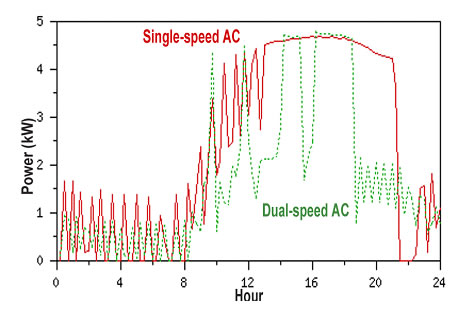
Figure 55 Power draw over
a 24-hour period, September 2, 2000.
Figure 55 shows the reduced power draw of the two-speed
compressor (green, dotted line) over a 24-hour period on
September 2, 2000. With the unit operating at low-speed for
most of the day, the cooling energy savings were 28% when
compared to the energy use in House A. Average daily cooling
energy was reduced by about 12% over the monitored period.
An added benefit of the two-speed air conditioner was 20%
greater moisture removal on days with an outdoor dewpoint
above 60 F.
Savings from Duct Repair and POS Ventilation: In addition
to comparing one house to the other, the BAIHP team also
compared home performance before and after ductwork and ventilation
system changes were made.
To make the comparison, duct and other leaks were sealed
in both houses until the two were equally airtight. The ventilation
method in each home also was changed from exhaust-only to
a positive pressure system (POS). With exhaust-only ventilation,
bathroom fans removed stale air from the home which caused
fresh air to be pulled in through the building envelope.
To simulate occupant use, two bath exhaust fans were operated
by a timer for three hours in the morning and six hours in
the evening.
In contrast to exhaust ventilation, the POS system introduced
a small amount of fresh air on the return side of the air
conditioning cooling coil. A POS system was installed in
each home at the same time the ducts were repaired. Subsequent
monitoring looked at the effects of this alternate ventilation
system. Tightening the ducts and installing a POS ventilation
system resulted in an 18% and 37% cooling savings in the
two homes. Only about 2% of these savings were attributable
to the ventilation system change, the remaining savings are
a result of duct repair.
- WSU
Energy House
Olympia, Washington
Technical Assistance by BAIHP Contractors Washington
State University Energy Program, Oregon Office of Energy
and Idaho Department of Water Resources, Energy Division
|
Figure
56 WSU Energy
House in Olympia, WA |
This
2600 ft 2 home was built beyond SGC standards and incorporates
Energy Star lighting and appliances. The home (Figure
56) has received significant national exposure through
WSU campus and alumni newsletters, tours, the BAIHP website,
and local and trade media including an article in the
Automated Builder magazine and a feature by KING 5 News
of Seattle.
WSU staff uses the house to try out innovative technologies
and testing methods.
In
2003, BAIHP staff developed a moisture case study based
on research at the WSU Energy House, published under a
separate Building America project. The WSU Energy House
has been monitored since 2000. Collected
monitoring data includes weather, temperature, humidity,
CO 2, CO, and eight differential pressures. Energy
use data is being collected for water heating, laundry,
fireplace and heating, ventilating, and air conditioning
(HVAC). Data from the house is available on the
BAIHP web page (under Current Data) and has been presented
to the building science, indoor air quality (IAQ) and
HVAC research communities at conferences sponsored by
ASHRAE, Air Infiltration and Ventilation Center (in the
UK), HUD/NIST, NFPA, and BTECC. (See
also Appendix D, WSU)
Working
with Ecotope, ASHRAE, and the Energy Conservancy, BAIHP
staff conducted “Delta Q” and “nulling” duct
leakage tests in 2001. Follow up pressure tests
and analysis of test data conducted in 2002 indicate
these tests are effective methods of measuring duct leakage
in manufactured homes, and may be included in the upgrades
to the National Fire Protection Association-501 standards
for manufactured homes.
Blower door and duct leakage testing indicate very good
whole house and duct airtightness (2.4 ACH50 and 61.6
CFM50 out). Tracer gas testing demonstrated that the
use of a furnace-based intake damper does not change
the leakage rate of the home.
In 2004, moisture problems associated with siding and
trim details were eliminated using and an improved window
flashing system. The adoption of this system is currently
under discussion with some manufacturers, and NFPA-501.
|


 You
are here: >
You
are here: > 